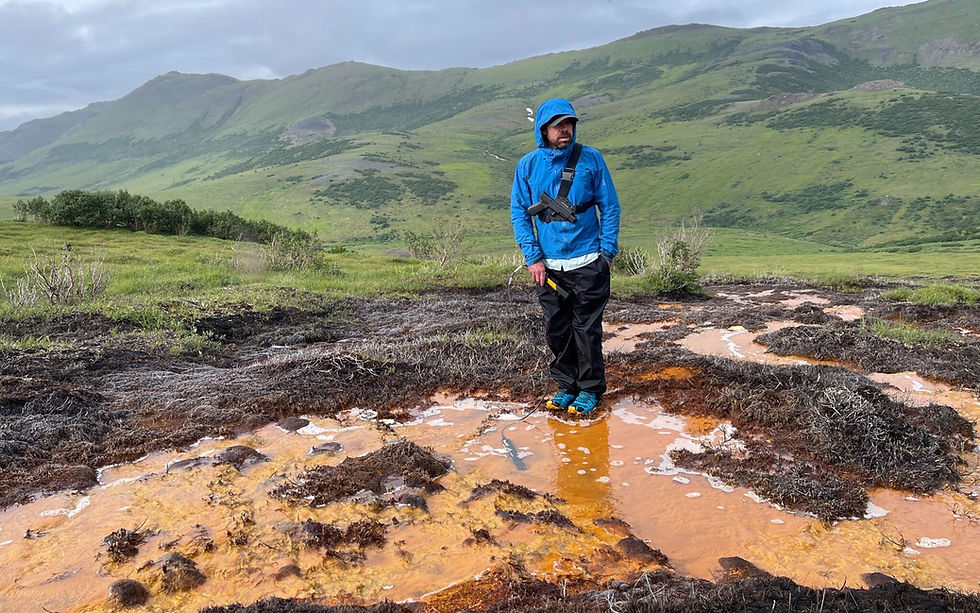When permafrost thaw turns Arctic Alaska river red, toxicity levels rise, scientists find
- Alaska Beacon

- Sep 29
- 6 min read
A study of the ‘rusting’ Salmon River and its tributaries in Kobuk Valley National Park suggests that permafrost thaw is causing wider ecological problems

By Yereth Rosen
Alaska Beacon
When scientists Patrick Sullivan and Roman Dial were heading to a remote area in the Brooks Range in 2019 to map the spread of woody plants there, they were looking forward to seeing a celebrated river that author John McPhee described decades ago as having the “clearest, purest water I have ever seen flowing over rocks.”
What they found in the Salmon River, a waterway that flows through Northwest Alaska’s Kobuk Valley National Park, was much different than what McPhee described in his landmark 1976 Alaska book “Coming Into the Country.” The waters Sullivan and Dial found were reddish-orange and murky from loads of minerals flowing into them.
The Salmon River and its tributaries had become transformed into “rusting rivers,” a phenomenon caused by climate change in permafrost regions.
“The permafrost is thawing, and it’s essentially acid rock drainage that’s occurring. These sulfite minerals are being exposed to oxygen and water for the first time in thousands of years and it’s releasing acid which is leaching metals out of the rocks to the streams,” said Sullivan, who heads the Environment and Natural Resource Institute at the University of Alaska Anchorage.
The problem goes beyond aesthetics, according to further research by Sullivan, Dial, who is at Alaska Pacific University, and their colleagues.
The Salmon River, a designated wild and scenic river, and its tributaries are so tainted by acid-rock drainage that their concentration of metals is considered toxic to chronically exposed aquatic life, they found.
Water samples taken in the summers of 2022 and 2023 found that the river and almost all of its tributaries were carrying metals at levels above U.S. Environmental Protection Agency and state of Alaska standards, according to a recently published study by Sullivan and his colleagues. A variety of metals were showing up in amounts dangerous to aquatic life: iron, cadmium, aluminum, nickel, zinc and copper, their study found.
The “rusting rivers” pollution is similar to the kind of pollution that can happen from hardrock metals mining. But unlike the case with mining, it is happening in the absence of human development, and it is happening over diffuse spots, whereas a single point source at a mine that could potentially be controlled.
“This wild and scenic river in the heart of Kobuk Valley National Park, it’s about as protected as you can get and as remote as you can get. And it’s kind of falling apart,” Sullivan said.
The study, published in the journal Proceedings of the National Academy of Sciences, summarized the situation in its title: “Wild, scenic, and toxic.”
There are places around the Arctic where rust-red rivers have been that way for centuries, like Canada’s Arctic Red River, also known in the Gwich’in language as Tsiigehnjik, meaning “iron river.”
But for the Salmon River, the change was abrupt.
The Bush pilot who ferried Sullivan and Dial to the site in 2019, who described the river’s appearance as similar to sewage, said it had just happened that year.
The toxicity findings are potentially ominous for fish health.
The timing of the change suggests that thaw-induced acid rock drainage could be one of the many factors depressing western Alaska salmon runs, the study found.
Salmon runs have been disastrously low in the region for the past few years, sometimes precluding even traditional subsistence harvests that are relatively small in scale but hugely important to culture and food security.
At the very least, the timing is a coincidence, Sullivan said. “It’s identical to what you would expect if these degrading streams were impacting spawning success,” he said, pointing out that most of the chum salmon that returns to the Kotzebue Sound area do so at the ages of four of five years, after emerging from the spawning rivers and swimming around in the ocean.
There is too little evidence for now to definitely link the rust-tinted waters of the Salmon River to poor salmon runs, Sullivan said. That is largely because there is too little known about that river’s fish populations, though the name suggests that the river was important to salmon in the past, he said.
It appears to have been that way in the 1970s, when McPhee was there boating there, fishing, camping and collecting information for his book.
At that time, the water was so clear that the riverbed was “as distinct as if the water were not there,” McPhee wrote. Those clear waters chock-full of oval-shaped salmon swimming upstream to spawn, he wrote. “Looking over the side of the canoe is like staring down into a sky full of zeppelins,” he wrote.
The recent proliferation of rusting rivers is not limited to Alaska and other parts of the Arctic. There are affected high-altitude areas that have permafrost, glaciers or both, including Switzerland and neighboring parts of the Alps, Peru and parts of Colorado.
In Alaska, the rusting rivers phenomenon is more pronounced in the western part of the North Slope than in the eastern part, Sullivan and Dial have found. Their past studies linked the vegetation changes in the northwest to more pronounced warming on the Chukchi Sea side of Alaska’s Arctic than on the Beaufort Sea.
That spread of woody plants is detrimental to tundra caribou that eat lichen and moss, and could help explain the decline in the Western Arctic caribou herd, which has a habitat that is changing more quickly than that of the Porcupine caribou herd on the eastern North Slope, they found.
After Sullivan and Dial encountered multiple rusting rivers during their plant studies, they felt compelled to alert fellow Alaskans about the situation.
They penned a 2022 column for the Anchorage Daily News. And they embarked on their further studies, which wound up generating a small National Science Foundation grant, creating partnerships with scientists at other universities who are experts in biochemistry and, ultimately, the newly published study on toxicity.
But before then, when they were expecting to see the same conditions that McPhee did in the 1970s, Sullivan packed a fishing rod with the gear he took on the trip to the Salmon River.
His attempts to fish in the murky, opaque water proved futile, however. “I think I tried for, like, five minutes and then I quickly realized that I was wasting my time,” he said.
That experience suggests that there might be further ecological impacts of the cloudy, rusted waters, he said.
“I think it would be very hard, for instance, for a bear to fish for a salmon just because of the turbidity. Raptors would have a really hard time catching a fish if they were fishing there,” he said, citing the suspended solids that make the water opaque.
For now, Sullivan and other scientists are using satellite imagery to spot other rivers and streams that might be similarly affected. The imagery is useful not just for spotting acid-tinted streams but the point sources in the tundra, he said.
It would be helpful to have more research on the region’s fish to explore whether they are carrying metals in their bodies, he said. Another topic of study could be the response of chum salmon in the region, as the species does show the some ability to shift habitats, he said.
Yet to be determined, Sullivan said, is how long this rusting river situation will last.
“It’s possible that this will kind of run its course over some period of time. And once the unweathered sulfite minerals have been oxidized, then it’s likely that the stream will turn back to clear again,” he said. “But we have no idea when that process might reach its conclusion and how many new acid seeps might develop.”
• Yereth Rosen came to Alaska in 1987 to work for the Anchorage Times. She has been reporting on Alaska news ever since, covering stories ranging from oil spills to sled-dog races. She has reported for Reuters, for the Alaska Dispatch News, for Arctic Today and for other organizations. Alaska Beacon is part of States Newsroom, the nation’s largest state-focused nonprofit news organization.














